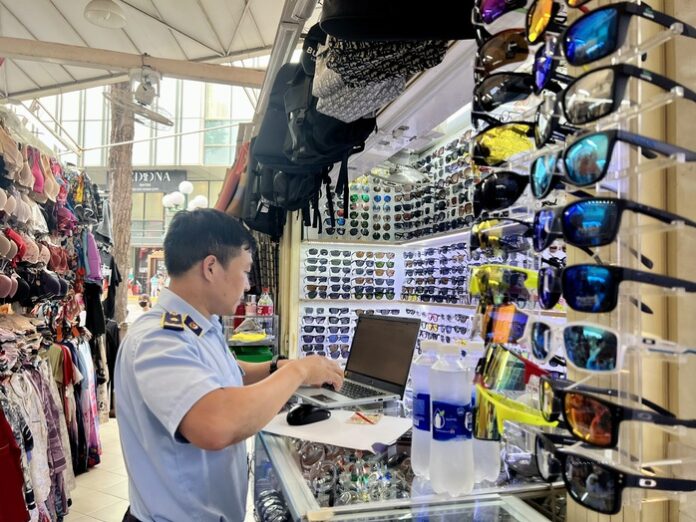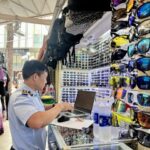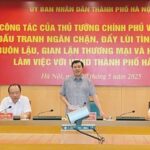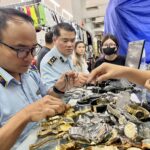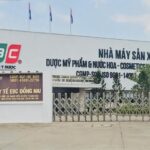In light of the recent string of exposed and thwarted cases of counterfeit production and trading, NLD reporter, Nguyen Viet Hong, Vice Chairman of the Ho Chi Minh City Consumer Rights Protection Association, shared his insights on the long-standing issue of counterfeiting, which has gained momentum in recent times, exacerbated by the rise of digital platforms.
Those involved in the production and distribution of counterfeit goods are taking advantage of the lax control over new distribution channels, including social media, e-commerce platforms, and livestreaming. Meanwhile, the legal framework and regulatory sanctions have struggled to keep pace, creating loopholes that enable these illegal activities to thrive.
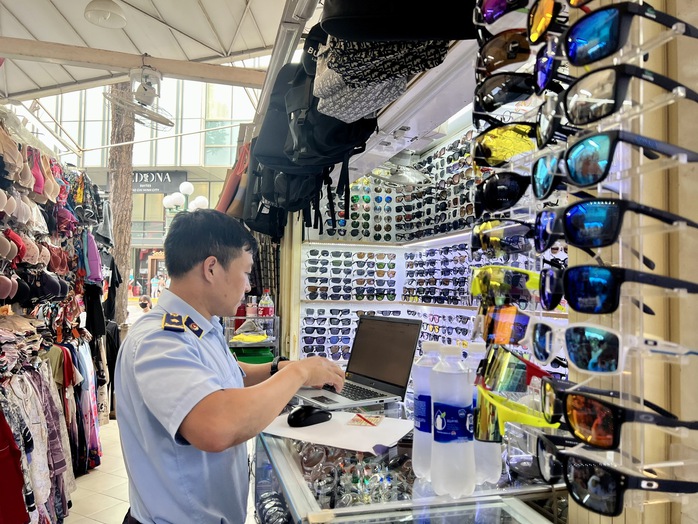
Market management forces inspect goods at Saigon Square trading center, District 1, Ho Chi Minh City, on May 29.
In reality, counterfeiting and trading in counterfeit goods are becoming increasingly sophisticated and diverse, extending beyond the fashion and electronics industries. More alarmingly, many consumer goods directly related to health, such as food and medicine, are also becoming targets for counterfeiting.
In response to this situation, authorities have taken decisive action, conducting frequent inspections and successfully dismantling numerous hot spots and networks involved in the production and sale of counterfeit goods. However, even in major cities, markets and shopping centers specializing in counterfeit goods continue to operate, some even daring to do so openly, only shutting down when inspections occur, highlighting the audacity and defiance of this issue.
Mr. Hong expressed his hope that this crackdown will bring about positive change and contribute to reducing the prevalence of counterfeiting and imitation to the lowest level. He advised consumers to be extremely cautious when shopping, especially online, and encouraged them to report any instances of counterfeiting to the relevant authorities to collectively combat this issue.
Regarding businesses, Mr. Hong pointed out a common passive attitude towards brand protection. Many companies only react when counterfeits are widespread instead of taking proactive preventive measures. More alarmingly, some businesses hide the fact that their products have been counterfeited for fear of damaging their brand reputation and sales. “This inadvertently aids the continued existence and growth of counterfeiting,” he said.
Sharing a similar view, Ms. Phan Thi Viet Thu, Chairman of the Ho Chi Minh City Consumer Rights Protection Association, stated that counterfeits are currently sold everywhere, visible to everyone. She emphasized that with rigorous and meticulous management, along with effective strategies, it is entirely feasible to tackle and eradicate this issue. She also highlighted the crucial role of consumers in protecting themselves by conducting thorough research before making purchases.
However, Ms. Thu acknowledged the limited support and impact of the Association. “We only have mediation functions. In many cases, consumers complain about purchasing poor-quality goods, but when we invite the sellers for mediation, they do not show up. The Association also lacks the authority to impose sanctions,” she shared.
“Requesting Hanoi to Step Up Inspections at Hapulico Medicine Market and Ninh Hiep Market to Curb Counterfeit Goods”
“Deputy Minister of Industry and Trade, Nguyen Sinh Nhat Tan, has instructed Hanoi authorities to intensify inspections in areas prone to smuggling, commercial fraud, and counterfeit goods. Specifically, he has identified hotspots such as Quang Minh Industrial Park, Hapulico medicine market, Ninh Hiep market, and various craft villages. These locations have been flagged as potential hubs for illicit activities, and the Deputy Minister has emphasized the need for heightened vigilance and enforcement to curb any unlawful practices that may occur within these premises.”
“Police Raid in Dong Nai Uncovers Nearly 300 Tons of Counterfeit Fertilizer”
The authorities seized a total of 62 tons of finished fertilizer products and 11,500 bags of raw materials, weighing a total of 230 tons.

